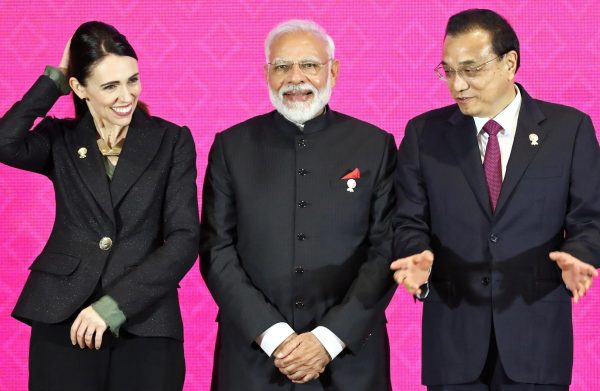With text-based negotiations for all 20 chapters of the agreement now concluded among the other 15 participating countries, the decision to opt out of RCEP could not have been an easy one for Modi. His own hand-picked advisory panel had recommended just a few days prior that India opt in.
On the one hand, India registered a bilateral trade deficit with 11 of the 15 RCEP participating countries in 2018–19. There was reason to believe that these deficits — particularly the all-consuming goods deficit with China — would increase if India joined RCEP. A pattern is evident in India’s prior preferential trade agreements with Japan, Korea and ASEAN. An uptick in overall exports is overshadowed by a larger rise in manufactured goods imports that displaces many vulnerable domestic producers.
Indeed, in each of the three instances, goods imports from the relevant country grew at a much faster pace than imports from the rest of world. The scale of the deficit in electronic goods and related parts could have even tipped the economy towards a current account contingency.
In this thinking about trade strategy, India has fallen for the flawed logic of Mr Trump on trade deficits. The flip side of trade deficits is capital imports. And India is desirably a significant capital importer, with capital goods imports increasingly serviced by its major partners in the region.
Economists posit that plurilateral trade agreements such as RCEP are ‘welfare enhancing’ for India. But without the politically challenging reform of India’s factor markets that could enable its small and medium enterprises to slot themselves profitably within East Asia’s vibrant value chains, the likelihood of widespread displacement and steep unemployment was high and could not be glazed over.
On the other hand, India desperately needs to sign on to both an export-oriented growth model and a regional integration strategy if it is to ever stimulate its latent manufacturing prowess and overcome its steep development challenges. RCEP provided a gateway on both these fronts.
Export sophistication — the production of sophisticated tradable goods that are conducive to high productivity gains, spillovers and agglomeration effects — is the single most important determinant of sustained growth in late-developing and industrialising economies. To the extent that the other standard determinants of growth — such as human capital, institutions, financial development and trade openness — raise an economy’s growth potential, they do so by contributing to increasing the economy’s production of sophisticated tradable goods. It is little wonder, then, that no major industrialising economy has maintained a 7 per cent plus growth rate without a sharp and sustained growth in manufactured goods exports or capital imports that both lift productivity.
Investment and exports acting in concert — ideally foreign direct investment steered towards labour-intensive and export-oriented manufacturing — must become a key foundation of India’s growth going forward. With Modi enjoying a huge political mandate, RCEP furnished a concerted liberalisation framework that could have both incentivised a bold political push to reform India’s factor market distortions and propelled the country towards his ‘Make in India’ target. No amount of tinkering with the ‘Ease of Doing Business’ rankings will achieve those in the same way.
The implications of joining RCEP on the regional integration front and for Modi’s ‘Act East’ policy were just as acute. India does not participate in the Asia-Pacific Economic Cooperation (APEC) forum, where best practices across a range of trade and digital economy endeavours are formulated. It is not a member of the Chiang Mai Initiative that has evolved from a bare-bones currency swap arrangement into an embryonic form of Asian financial regionalism. It was excluded from the Comprehensive and Progressive Trans-Pacific Partnership negotiations, and is only marginally attached to the region by way of the shallow economic partnership agreements with Japan, South Korea and the ASEAN countries.
RCEP afforded an opportunity for New Delhi to hitch its wagon to the global epicentre of ‘open regionalism’ at a time when protectionism and populism are casting a pall over India’s economic rise in the global system. The developing country-centric, pro-integration alternative that RCEP furnished could have also structurally reframed the economic and political character of the triangular China, India and Southeast Asia relationship.
Now without an economic integration strategy in Asia, India’s ‘Act East’ policy risks amounting to little more than becoming the naval doorman of the Indo-Pacific. India’s RCEP exit will also compound the less-than-high regard that it is held in by many of its Southeast Asia peers and does not bode well for the long-term durability of its ‘Act East’ policy.
By signing on to RCEP and instituting the accompanying structural reforms at home, Modi could have made an unequivocal break with the disappointing outcomes of past preferential trade agreements signed. That opportunity has now gone begging.
Sourabh Gupta is a Senior Fellow at the Institute for China-America Studies (ICAS) in Washington DC. A shorter version of this article appeared in The Hindu.

